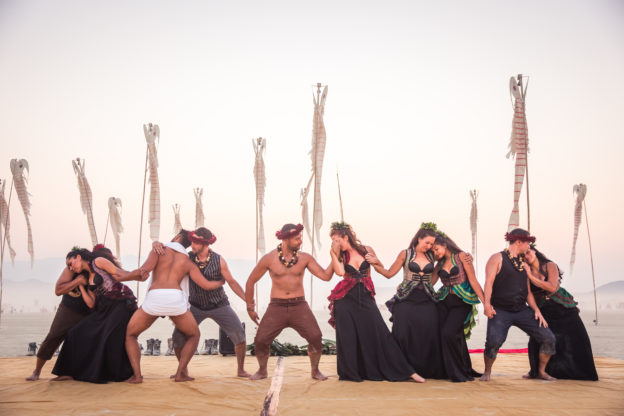
01 Oct In Practice: Patrick Makuakane’s Hula in Unusual Places
DancersGroup.org | October 1, 2018
The last time I interviewed Patrick Makuakane, Artistic Director of Na Lei Hulu I Ka Wekiu, his company had just received a Special Award from the Izzies Committee for The World According to Hula. When he introduced the company, the emcee made a cringe-worthy Hollywood hula gesture, you know the one—Lucille Ball does it in Dance Girl, Dance (1940), Debbie Reynolds does it in Singin’ in the Rain (1952), the Minions do it in Despicable Me 3 (2017). Makuakane graciously accepted the award and gracefully admonished the emcee for promoting the very stereotypes he has long sought to dispel.

This was in 1999. Today, Makuakane is happy to report that hula is living its hashtag moment, at least in the Bay Area; folks have awakened to the cultural realities of hula as an art form, cultural practice, and way of life. This month, Makuakane and company present I Mua: Hula in Unusual Places at the Palace of Fine Arts. Right away the subtitle got me thinking about what constitutes an unusual place for hula, and the only thing that came to mind was “not Hawai’i.” I assumed that the moment hula hits the mainland it becomes unusual.
Makuakane explains that San Francisco both is and isn’t an unusual place for hula. Hawaiian music and dance were featured at the Panama Pacific International Exposition at the 1915 World’s Fair at the Palace of Fine Arts, where the company has its home season, and Hawai’i Pavilion headliner Lena Machado and her group were voted audience favorites at the 1939 and 1940 World’s Fairs on Treasure Island: “So there has been a longstanding appreciation for Hawaiian music and a relationship between California and Hawai’i, in part because of the proximity. Hawaiians move here more readily than anywhere else, making it easier for us to do our cultural work here.” Still, Makuakane concedes, “considering its traditional origins, this is a strange place to be doing hula. I guess because I’ve been doing it for thirty-something years over here it doesn’t feel strange anymore.”
What did feel strange was when Makuakane brought 10 members of his company to Burning Man for the first time three years ago. Indeed, images of the company dancing in a haze of gray playa dust contrasts sharply with visions of blue waves and lush green. But the burners embraced the hula dancers: “I can’t tell you how blown away I was by the inventiveness, the subversiveness, the acceptance, the radical expression of self, and the loving embracing community—it reminded me of our community, very welcoming.” The ubiquity of electronic music at Burning Man also inspired Makuakane: “I’ve been fusing electronic music with my dance for a while now. I put everything I had in my arsenal—electronic music, traditional chants—and people loved it.” When we spoke this past August, Makuakane was about to bring his whole company to Burning Man, an unusual place turned desert home for hula.
I Mua: Hula in Unusual Places is a proscenium performance that draws its spirit from Makuakane’s Hit & Run Hula, a series of hula flash mobs that have taken place all over San Francisco, in New York City (Times Square, Brooklyn Bridge), and, one time, on a Hawaiian Airlines flight from San Francisco to Hawai’i. Makuak?ne loves the way these performances work the element of surprise in two directions—audiences don’t see it coming and the dancers don’t know how they’re going to be received: “When Hawaiian Air hired twenty of us to dance on the plane to inaugurate a new flight out of San Francisco, they played one of oursignature pieces, I Left My Heart in San Francisco. One by one the women got up to dance in the aisles from first class all the way down to the back. I remember looking back and seeing this one gentleman very annoyed because he was trying to open the overhead bin to get his bag and there was this hula dancer in front of him. He was waiting for her to go back so he could jump up and remove his bag. For me that just made it. That was perfect. Not everyone was like, Oh, wasn’t that pretty. This guy was like, You’re in my way, I need to get my bag. Life is happening as it moves.”
Makuakane never gets permits to perform Hit & Run Hula and he has learned how long it takes on average for law enforcement to show up: “These pieces are a minute to a minute and a half long. Several times we’ve just finished a piece and some security person will come up and say, Hey, you can’t do that here although it’s really nice. And I just turn around and say, I’m really sorry, thank you, we’ll be on our way. But my piece is finished already!”
Makuakane calls his style of hula, hula mua, which he defines as “the kind of hula that moves forward.” The upcoming performance is titled I Mua, a common term in Hawai’i that means “move ahead,” among several related meanings like
“straight ahead” and “let’s do it!” Makuakane says he titled the show “in a very Hawaiian way. That is, you never really refer to something directly but obliquely. Especially in mele or Hawaiian music, or poetry, the mele that accompanies the dance often speaks in metaphors and hidden messages. The power of deduction is what’s interesting.” I wondered aloud whether modernist dance forms have suffered from the autonomizing gesture that dislocated movement from other forms of expression, severing the ties to verbal speech in ways that prevents audiences from using that power of deduction to make sense of and thereby more deeply enjoy the work. “I definitely engage in that conundrum myself,” Makuakane said, “because hula is a dance form that we dance to Hawaiian language and 99.99% of my audience doesn’t know what the dances are about. So in my shows I incorporate narration in a way that gives the audience a little hint but doesn’t overwhelm them.”

Makuakane’s concept of an unusual place encompasses the geographic, the auditory, and the corporeal. Hula mua challenges essentialist theories that certain dances belong on certain bodies to certain music in certain places.
One of Makuakane’s most cherished sites for teaching hula is San Quentin State Prison: “I teach in the chapel area. It’s not a hula class, it’s a Hawaiian spiritual group meeting, a service, under the auspices of the Religious Freedom Act. I went to (Catholic) church throughout grade school and high school, and never felt any connection. Then I started hula and realized this thing I’m feeling, this connection out of self to the world, I think this is what I’m supposed to be feeling at church. In some ways I can see that in the guys when they’re in class. There’s this connection with community, arms and hands moving in space accompanied by some kind of chant or music. It’s a time when I see their walls come own, and they’re vulnerable and open, and always very respectful. It just goes to show not only the power of dance—I hate that phrase, it’s more than that. It’s community, it’s acceptance, it’s acknowledgement, all of that plays into a successful community and then you add dance to it and, wow, how could you not be inspired and interested in that.”
When Makuakane was growing up on Oahu in the 1960s, native Hawaiian culture was very much on the periphery of his family and community events. But in the 1970s, a Hawaiian cultural renaissance invited people to ask questions about their identity as native Hawaiians. According to Makuakane, many moved into the fields of music and dance to find answers to those questions: “I found all those answers in hula. Dance is what saved our culture and language in the 70s. Now we’re in the midst of another renaissance of knowledge, people going back to study traditional applications and methods, dancing, canoeing, farming, wayfaring, sending their kids to Hawaiian language immersion schools. I’m amazed.” And since all identities are intersectional identities, hula offered Makuakane a way to embrace his ethnicity, spirituality, and sexuality: “In high school, when I told my mother and sister that I was going to be a hula teacher, they were like, ‘Oh, so you are gay!’” They didn’t really say that. But when Makuakane brought that conversation up 25 years later after earning the right to be a kumu hula, he asked his sister and mother, “Do you remember that conversation? Yes. And did you think that? Yes.” Makuakane had a good laugh over that one.
Stereotypical assumptions aside, Makuakane did find hula to be a place where he felt safe being himself: “My main teacher was gay, not out or anything, but a flamboyant guy being himself; he didn’t look like he was hiding anything. And he was the leader of all these young guys who were football players, big macho guys, learning to dance by moving their hips. And I was like, Where’s that magic wand at?” As hula began having its renaissance in the 1970s, more and more boys and men were drawn to the form as a way to express their native identity: “It was becoming more acceptable. You were still called a fag, and some groups were deemed more faggy than others. My group was one of the faggier groups.” This sparked a movement to develop a hypermasculine style of dance, “almost as if a way to let people know [grunts], we’re not gay.” Though this style may be traced to lua, Hawaiian martial arts, which “traditionally speaking, have a close relationship with hula, in the oldest archival footage of people dancing hula it’s very soft and flowing.”
Makuakane hadn’t planned to stay in San Francisco when he moved here to be with his partner in 1983. After three months, he’d found home. “I couldn’t do a show in Hawai’i called Hula in Unusual Places. Here I can. I am going to take the show back to Hawai’i next year, but it was important for me to plant the seeds in San Francisco. The gay scene, the modern dance scene, this unique experiment with life.” Makuakane’s whole career has emphasized the fact that dances are connectedto places and people, and, at the same time, are roomy enough to include and engage other places, other people: “Here I am doing hula outside of the mothership, and I feel like I’m set free.”
Read more at: https://dancersgroup.org/2018/10/practice-patrick-makuakanes-hula-unusual-places/



